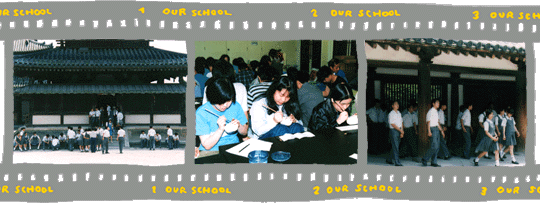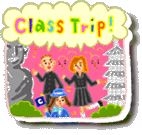|
|||
| Up to this point
on their trip, the students have been traveling by train or bus, and have
stayed in one big group. But on the third day, the students get to do
what they have really been looking forward to doing: split up into smaller
groups and sightsee on their own, without the supervision of their teachers.
In their small groups, the students hit the streets of Kyoto in taxis
to get around the city. For perhaps the first time in their lives, the
students are responsible for calculating their own expenses, such as temple
admission fees and the cost of lunch; and for budgeting their time so
that they can make every stop they have scheduled. Their tour includes
temples like Kiyomizu-dera,
famous for being built out over a steep cliff; and Ryoan-ji,
known for its rock garden. They also visit Sanjusangen-do,
a temple building that contains 1,001 statues of Kannon, an important
Buddhist divinity. Sanjusangen-do is also known for the archery competitions
held during Japan's Edo period (1603-1868). Another place on the students'
itinerary is Nijo
Castle, built by the warlord Tokugawa Ieyasu (1543-1616) as a Kyoto
stronghold.
|
|||
 |
|||
| |||
| Before their trip,
the students learn about Kyoto and Nara in class. After the trip, they
summarize their experience in reports and essays, which they display at
the school fair. One unique tradition at Kojimachi Middle School is composing
haiku for the class trip album. For many years now, the students have
been writing haiku based on what they saw and felt on the trip, and pasting
their haiku alongside the photos in the albums.
The class trip is one of the few long-distance excursions for students at Kojimachi Middle School. It is looked forward to eagerly and is also a great learning opportunity. |







